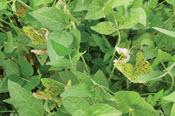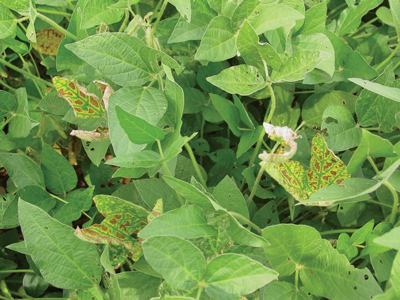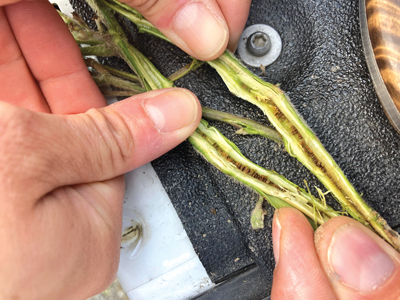
Solving the Case for Disease-Free Fields & Higher Yields in 2024
By Paul Hermans
With harvest complete, focus shifts to seed selection for the 2024 growing season and beyond.
Looking back allows us to predict future crop performance. From a soy-bean perspective, we can learn lots from the 2023 growing season to help us succeed in the future. A little detective sleuthing will help us win big – solving crop-scene cases and achieving optimum yields.
Mother Nature threw lots of curveballs at us in 2023. Excessive rainfall during critical periods, a cool start to spring, and ideal conditions for disease development led to an interesting year scouting fields and determining what was happening in the soybean crop.
In my region, white mould was the main disease to contend with this year. However, we are seeing more soybean “white mould mimics” showing up in our area. Driving by fields and doing a simple scout from the driver’s seat, a lot of these soybean mimics look the same. Brown, dying/dead leaves within patchy areas of a field that look off-colour compared to the rest of the field were common this year.
However, some “boots in the field” inspection would reveal that it was not always white mould that was the culprit, robbing us of top-end yields.
So why was the 2023 growing season worse than some others?
Simply put, the environment this year overrode many factors. If you have heard of the disease triangle, you know what I am talking about.
With any disease, you need three factors for that disease to occur.
Let us use white mould in soybeans as an example.
You need a host (soybeans – or multiple other crops), you need a pathogen (white mould sclerotinia found in the soil), and you need the environment (wet soil conditions, humid canopy during flowering) for a disease to exist.
In 2023, the environment played a huge factor and overpowered many soybean fields, increasing the odds of white mould showing up.
Let us look at some key soybean diseases and their mimics.
White Mould
As the old saying goes, you need high-yield environments to have white mould.
White mould is a fungal disease that occurs during flowering, favouring cool, wet conditions and tall, lush soybeans that canopy quickly.
As the disease progresses, tissues rot due to sclerotinia within the plant’s vascular system, leading to rapid wilting and dying. Keep in mind, when you see the “cottony toothpaste look” of mould on the plants, the initial infection occurred three to four weeks earlier. From the road, white mould necrotic leaves can look like other diseases mentioned below.
Sudden Death Syndrome (SDS)
SDS starts affecting soybean plants early in the growing season, but we do not see leaf symptoms until later.
During the reproductive stages, the fungus produces a toxin that damages the leaves, causing interveinal chlorosis. The distinct yellow and brown necrotic areas between green midveins and lateral veins, combined with a healthy stem (unlike BSR; see below), help distinguish this from white mould and other diseases like BSR.

Research has shown that SDS is more problematic if Soybean Cyst Nematode (SCN) is also present in fields.
This is because SCN injures the root system, allowing the SDS pathogen to enter the root.
If you find SDS in your fields, these are candidates for SCN soil sampling – to first confirm the presence of SCN and, if present, determine the severity for future crop planning of SCN varieties and other management practices.
Soybean Cyst Nematode (SCN)
SCN is starting to make its presence known in Eastern Canada.
Although not technically a disease, its symptomology can be confusing when scouting.
During its life cycle, eggs overwinter in cysts in the soil. Eggs hatch in the spring, and newly hatched nematodes move underground to penetrate the roots, setting up a feeding station. The females continue feeding on the roots after mating, thus causing entry points for other diseases, as well as causing stress to the soybean plant.
Soybeans tend to be stunted, and leaves become chlorotic in nature, slowing canopy growth compared to other parts of the field.
Because the soybean cysts are small (smaller than soybean nodules and about the size of a ballpoint pen tip), digging up the soybean plant and washing the roots off is advisable for analysis.
Brown Stem Rot (BSR)
BSR is caused by a fungus that survives in soybean residue and affects the soybean plant early in the season.
Symptoms of leaves senescing usually do not show up until mid-August during the reproductive cycle of the plant. From the road, it looks like white mould and/or SDS symptoms. In this situation, you can use a knife and carefully cut and inspect the stem to determine the disease.

BSR infected plants will have their stem infected, hence the disease name. Often, it looks like “stacked brown pennies” inside. Compared to other diseases that do not have the stem affected, this is a key way to tell it is BSR.
Do not get fooled. Knowing what reproductive season disease(s) you have will help you decide what seed agronomic traits to look for when buying next year’s seed.
Every soybean variety has its own agronomic strengths and weaknesses. As an example, some varieties have stronger scores on white mould, while differing on other disease scores mentioned above or vice versa.
Scouting your fields and being an agronomy detective will allow you to plan field-by-field soybean varieties that are suited to not only your management practices, but the disease present in that field.
A little planning goes a long way, for a higher success rate in the future based on historical diseases present.
Root Rots
Adding to the multitude of diseases found later in the season, 2023 saw a cool, wet growing spring, followed by rapid growth in June, with prolonged wet soil cycles. This was ideal for various root rots.
Sometimes root rots are hard to diagnose once you see them. Once one disease takes hold, other predatory-style diseases join in. With multiple roots rots taking place, a simple lab diagnosis using DNA multiscan helps.
In our area we were seeing fusarium, rhizoctonia, pythium and phytophthora root rot showing up more than other years.
Look carefully at disease scores when selecting soybean seed for early root rot disease as well as seed treatments. There are differences in seed treatment products on the market. Gone are the days of simply saying, “I have seed treatment on my seed; I am good to go.”
Reach out to your trusted agronomy supplier and discuss more strategies for managing each disease. It may seem like it is an overwhelming task taking on soybean diseases.
A little planning and understanding on how, when, why and where the disease strikes goes a long way to helping control that disease down the road.
Be a crop-scene detective in 2024. Happy sleuthing and seed planning this winter – and in the future – for disease-free fields and higher yields. BF



Post new comment